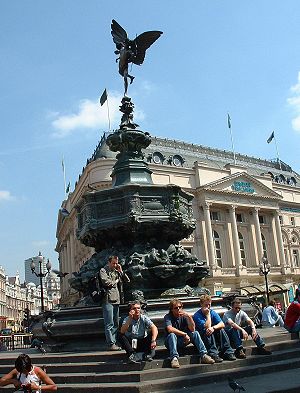Piccadilly Circus
Contents
1950s
During the 1950s Piccadilly Circus became the focus of queer commercial sociability[2] after the neighbouring Leicester Square suffered a demise in gay visited venues after the Met and the LCC clamped down on heterosexual vice, making gay men's presence less acceptable. On the southeast of Piccadilly Circus was the Lilypond, on the south was the Criterion, to the north on Glasshouse Street the Regent's Palace Hotel whose bar was popular for four decades. On the northeast was the Trocadero. Bars included the White Bear and Ward's Irish House. From the 1960s toilets in the underground station were frequented by gay men and rent boys plied their trade in the toilets and at the railings nearby (known as the 'meat rack').
1990s
On 5 September 1990 OutRage! organised a "kiss in" to protest against police arresting gay men for kissing in public[3]. A troop of cheerleaders urged everyone on - the first appearance in Britain of a new London House of the Sisters of Perpetual Indulgence. 400 people participated in the action with no arrests. It generated press, with the Guardian running a photo caption "kiss of death" and the Independent claiming that "unless homosexuals wish to alienate the public they should conduct themselves with restraint". It was a turning point in how the Met treated gay affection in public.
2000s
DTPM was hosted for several years at the Trocadero and was famous for being one of London's most fashionable clubs in regard to its music and DJs.
See Timeline of West End Bars and Clubs.
References
- ↑ Although always referred to as Eros, the statue is actually of the Greek god Anteros (Ancient Greek Ἀντέρως), god of requited love and brother of Eros (Ἔρως); it is part of a monument to the Victorian philanthropist the Earl of Shaftesbury,and is sometimes referred to as "the angel of Christian charity" - see Lloyd & Mitchinson (2006) The book of general ignorance: "Because of the bow and the nudity... everybody assumed it was Eros, the Greek god of love."
- ↑ Queer London, 2005
- ↑ OutRage! an oral history, 1998
